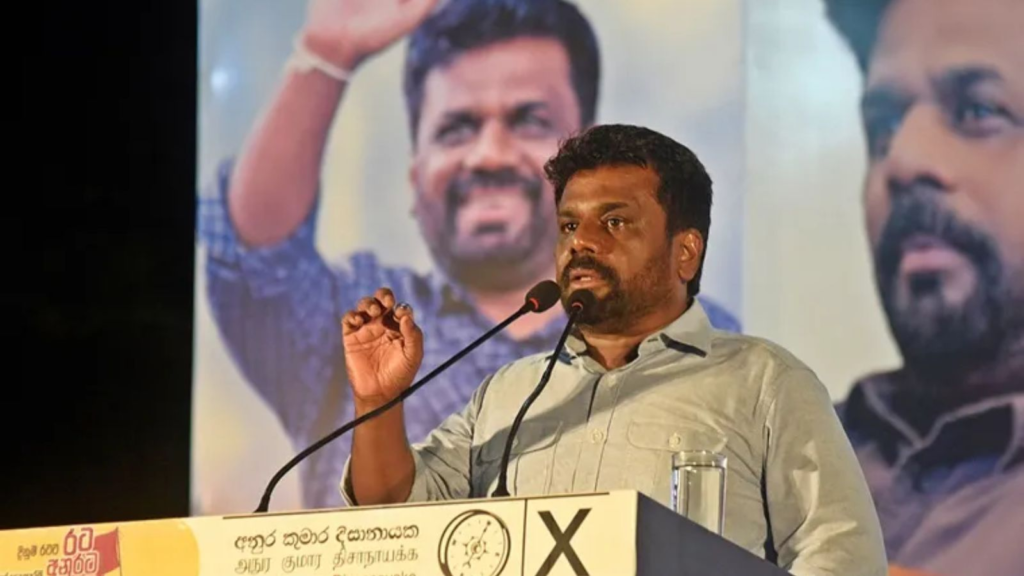Introduction: Anura Kumara Dissanayake
Sri Lanka has recently witnessed a significant shift in its political landscape with the election of Anura Kumara Dissanayake as its 10th President. His victory represents a departure from the traditional political elite that has governed the nation for decades. This article delves into the detailed timeline of events, the challenges faced by the country, and the perspectives of experts on what this change means for Sri Lanka’s future.

Background and Early Political Career
Anura Kumara Dissanayake, a prominent Marxist leader, has been a vocal critic of the traditional political class. He began his political journey with the Janatha Vimukthi Peramuna (JVP), or the People’s Liberation Front, a Marxist party known for its radical roots. First elected to Parliament in 2000, Dissanayake served briefly as the Minister of Agriculture and Irrigation under President Chandrika Kumaratunga’s administration. His early political career was marked by his strong stance against corruption and inefficiency within the government.
Political Rise and the 2019 Presidential Election
Dissanayake first ran for the presidency in 2019 but was defeated by Gotabaya Rajapaksa. Despite the loss, his campaign laid the groundwork for future political gains, as it highlighted his commitment to addressing the country’s economic and social issues. His focus on anti-corruption and economic reform resonated with a growing segment of the population dissatisfied with the traditional political establishment.
Economic Crisis and Political Turmoil
Sri Lanka has faced a severe economic crisis in recent years, primarily due to excessive borrowing for unproductive projects, mismanagement of resources, and the impact of the COVID-19 pandemic. The crisis led to a severe shortage of essential goods, skyrocketing inflation, and widespread public protests. The economic turmoil culminated in the resignation of President Gotabaya Rajapaksa in July 2022, following mass protests and public outcry over his handling of the crisis.
The 2024 Presidential Election: A Turning Point
The 2024 presidential election was a turning point for Sri Lanka. Dissanayake, representing the National People’s Power (NPP) coalition, won a decisive victory over opposition leader Sajith Premadasa and 36 other candidates. He received 5,740,179 votes, while Premadasa garnered 4,530,902 votes. This election marked the rejection of the traditional political elite, as voters sought new leadership to navigate the country out of its economic and political crises
Challenges Ahead for the New President
Dissanayake’s presidency comes at a time when Sri Lanka is grappling with severe economic challenges. The country faces high debt levels, a devalued currency, and an urgent need for economic reforms. Experts believe that Dissanayake’s ability to implement effective policies will be crucial in stabilizing the economy and restoring public confidence. His Marxist background and association with the JVP suggest that his approach to governance may focus on social welfare and economic equity.
Experts Opinions on Dissanayake’s Leadership
Many political analysts are cautiously optimistic about Dissanayake’s presidency. Dr. Paikiasothy Saravanamuttu, Executive Director of the Centre for Policy Alternatives, commented that “Dissanayake’s victory represents a desire for change and accountability. His ability to deliver on his promises will be the true test of his leadership.” Similarly, Professor Jayadeva Uyangoda, a leading political scientist, noted that “the new president must address the deep-rooted structural issues in the economy and the political system to ensure sustainable development and stability.”
Timeline of Key Events
- 2000: Anura Kumara Dissanayake elected to Parliament.
- 2019: Runs for president and loses to Gotabaya Rajapaksa.
- 2022: Gotabaya Rajapaksa resigns amidst economic crisis and public protests.
- September 22, 2024: Dissanayake wins the presidential election.
- September 23, 2024: Sworn in as the 10th President of Sri Lanka(Express & Star)(euronews).
Conclusion
Anura Kumara Dissanayake’s presidency marks a new chapter in Sri Lanka’s history. His leadership will be pivotal in addressing the country’s economic challenges and restoring political stability. While the road ahead is fraught with difficulties, his victory signifies hope for many Sri Lankans seeking a more equitable and transparent government.
References and Further Reading
- Express & Star: Anura Kumara Dissanayake sworn in as Sri Lanka’s new president
- Euronews: Sri Lanka swears in left-wing Anura Kumara Dissanayake as president
FAQs and Answers:
- Who is Anura Kumara Dissanayake?
- Anura Kumara Dissanayake is a prominent Sri Lankan politician and the newly elected President of Sri Lanka. He is known for his Marxist views and leadership of the Janatha Vimukthi Peramuna (JVP).
- What are the main challenges faced by Anura Kumara Dissanayake as President?
- His main challenges include stabilizing the Sri Lankan economy, tackling corruption, and implementing systemic reforms to improve public services and governance.
- What is the National People’s Power (NPP)?
- The NPP is a political coalition in Sri Lanka, formed by the JVP and other left-wing parties. It aims to provide an alternative to traditional political forces and promote social justice and economic equity.
- How did Anura Kumara Dissanayake’s political career begin?
- His political career began with his involvement in the JVP as a student leader. He was first elected to Parliament in 2000 and has since held various positions, including Minister of Agriculture.
- What is the significance of the 2024 Presidential Election in Sri Lanka?
- The 2024 election marked a significant shift in Sri Lankan politics, as it demonstrated the public’s desire for change and rejection of the traditional political elite.